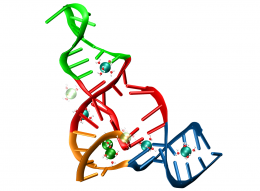Powerful supercomputer peers into the origin of life

(PhysOrg.com) -- Supercomputer simulations at the Department of Energy's Oak Ridge National Laboratory are helping scientists unravel how nucleic acids could have contributed to the origins of life.
A research team led by Jeremy Smith, who directs ORNL's Center for Molecular Biophysics and holds a Governor's Chair at University of Tennessee, used molecular dynamics simulation to probe an organic chemical reaction that may have been important in the evolution of ribonucleic acids, or RNA, into early life forms.
Certain types of RNA called ribozymes are capable of both storing genetic information and catalyzing chemical reactions – two necessary features in the formation of life. The research team looked at a lab-grown ribozyme that catalyzes the Diels-Alder reaction, which has broad applications in organic chemistry.
"Life means making molecules that reproduce themselves, and it requires molecules and are sufficiently complex to do so," Smith said. "If a ribozyme like the Diels-Alderase is capable of doing organic chemistry to build up complex molecules, then potentially something like that could have been present to create the building blocks of life."
The research team found a theoretical explanation for why the Diels-Alder ribozyme needs magnesium to function. Computational models of the ribozyme's internal motions allowed the researchers to capture and understand the finer details of the fast-paced reaction. The static nature of conventional experimental techniques such as chemical probing and X-ray analysis had not been able to reveal the dynamics of the system.
"Computer simulations can provide insight into biological systems that you can't get any other way," Smith said. "Since these structures are changing so much, the dynamic aspects are difficult to understand, but simulation is a good way of doing it."
Smith explained how their calculations showed that the ribozyme's internal dynamics included an active site, or "mouth," which opens and closes to control the reaction. The concentration of magnesium ions directly impacts the ribozyme's movements.
"When there's no magnesium present, the mouth closes, the substrate can't get in, and the reaction can't take place. We found that magnesium ions bind to a special location on the ribozyme to keep the mouth open," Smith said.
More information: The research was published as "Magnesium-Dependent Active-Site Conformational Selection in the Diels-Alderase Ribozyme" in the Journal of the American Chemical Society.
Provided by Oak Ridge National Laboratory















